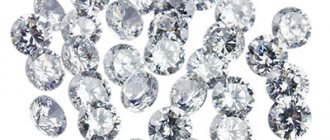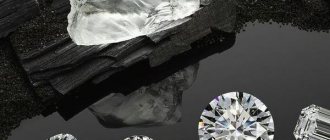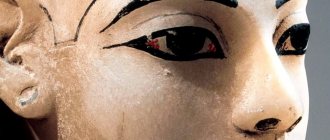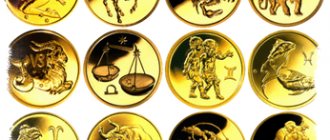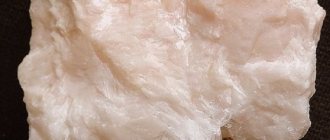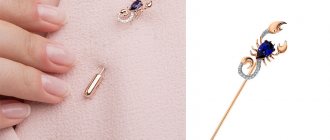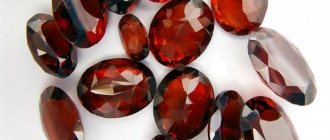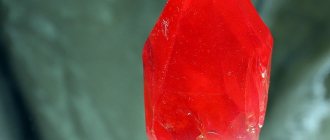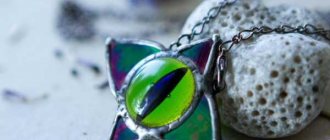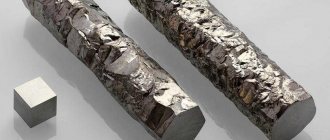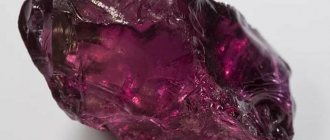Physical and chemical properties
Zircon chemical composition is zirconium orthosilicate containing from 1 to 4% hafnium. The mineral is most often radioactive, as it contains impurities of uranium and thorium, as well as rare earth elements, to varying degrees.
| Formula | ZrSiO4 |
| Color | Colorless, red, orange, brown to black, green, gray, blue, yellow |
| Probable impurities | Hafnium, uranium, iron, aluminum, calcium and others |
| Shine | Diamond |
| Hardness | 7,5 |
| Transparency | Most often crystal clear, less often translucent |
| Strength | Brittle due to porosity |
| Cleavage | Unclear |
| Density | 4.6-4.7 g/cm3 |
| singonia | Tetragonal |
Zircon - a palette of dizzying shades
Zircon is considered one of the oldest minerals on Earth. This fact was confirmed by scientists who collected Australian zircon and established its age at 4.4 billion years. Our planet is almost the same age.
Sparkling crystals are very popular due to their colorless effect. The intense shine and strong sparkles give the stone a magnificent appearance. But zircon can be not only colorless, but also all shades of the rainbow.
In the photo: zircon color palette.
History of the stone
In ancient times, people wore talismans with zircon and believed that it gave them strength and power. The ancient sages considered zircon their patron.
The gem got its name from the Persian word “tsargun”, which means “golden”. However, zircon is found in different shades, which is due to impurities present during the formation of the stone. These can be green, red, gray, brown and even black crystals. In ancient times, zircon was often confused with other stones of similar color: topaz, rubies, tourmalines, and amber. Transparent gems were passed off as diamonds. Outwardly, it resembles a diamond, for which residents of Eastern countries call it zircon - the “little brother” of the diamond.
In the 15th century, Europeans appreciated the brown-red crystals, which were called hyacinth. They began to make jewelry with this stone, which was popular with the nobility. A little later, other shades of zircon came into fashion.
In the photo: zircon in rock.
Types and deposits of stone
The main sources of jewelry zircons are deposits in Myanmar, Thailand, Cambodia, Vietnam, Madagascar, Sri Lanka, USA, Brazil, Canada, Norway, and Australia. In Russia, zircon is found on the Kola Peninsula, Yakutia and the Urals. Mining is carried out in granite and igneous rocks, as well as in kimberlite pipes. In most cases, stones are small in size, weighing up to 1 carat. Large specimens are found very rarely.
In nature you can find different types of zircon, differing in color:
- Hyacinth - the color palette ranges from orange to red-brown;
- Starlite - from blue to green. This type of nugget is very rare and is considered the most valuable type of mineral;
- Malacon - olive green to brown. It is rarely used in jewelry due to the small admixture of uranium;
- Matura diamond is colorless. It is also called Matar diamond or diamond-like. This gem is incredibly popular in the jewelry world. It is mined on the island of Sri Lanka. Colorless zircon is the purest form of the mineral and can be passed off as diamonds by unscrupulous jewelers.
- Ceylonese slang - pale straw yellow, yellow, honey. Sometimes this mineral can be passed off as chrysoberyl due to the similarity in shades.
In the photo: zircon color scheme.
Physical and chemical properties of stone
Zircon sparkles brightly when illuminated, but is inferior in the play of light to diamond. The stone is birefringent and can create the illusion that it has twice as many facets as it actually does.
The mineral itself is fragile and can easily be damaged when it comes into contact with other minerals.
The nuggets necessarily contain rare earth elements: copper, titanium, iron, zinc, calcium, aluminum, hafnium.
- Hardness on the Mohs scale – 6.0 – 7.5;
- Specific gravity – 3.9 – 4.7;
- Density – 4.6–4.7 g/cm3;
- Refractive index – 1.92 to 2.01;
- Variance – 0.039;
- Syngony – tetragonal;
- Cleavage is imperfect;
- The fracture is conchoidal, uneven;
- Color – transparent, yellow, gray, blue, shades of green, red, orange, brown;
- Transparency – transparent;
- Shine – diamond, strong;
- Refraction – high.
At the mineralogical level, zircon forms in felsic or metamorphic igneous rocks. If up to 10% uranium, thorium and hafnium are present inside it, then the stone is considered radioactive. Such specimens are not used in jewelry.
In the photo: zircon.
Magical and healing properties of the stone
Zircon is a crystal that is also called “attraction” because it helps to correctly understand a person’s goals and achieve them. For a long time, people believed that jewelry with this gem helps in concluding trade deals. And now zircon is a talisman for businessmen and entrepreneurs. Practitioners of esotericism say that if you wear jewelry with zircon to conclude a profitable deal, it will help you make the right decision and recognize a lie.
Mystics believe that the stone allows a person to unravel secret signs sent from above and receive answers to any questions.
Esotericists say that small transparent crystals arouse interest in science and develop mental abilities.
In the photo: zircon in rock.
Zircon has a wide range of healing properties and becomes an effective stone for the owner. Lithotherapists are confident that each shade of the mineral has its own healing power:
- Blue stones improve bowel function;
- Dark shades of zircon help with colds;
- Yellow-red increase appetite and remove toxins;
- Transparent ones accelerate metabolism and increase muscle tone;
- The orange and red shades of the stone cleanse blood vessels and improve the functioning of the body.
According to traditional healers, all zircons have a beneficial effect on the nervous system.
Who is zircon suitable for?
In terms of its energy, this gem can be combined with any sign of the Zodiac. Astrologers claim that for some signs zircon has a certain meaning:
- Aries will help to reveal their creative potential;
- Aquarius will strengthen their sixth sense and help them quickly navigate unexpected situations;
- Dev will teach you how to cope with a bad mood and charge you with optimism;
- It will help Gemini to cope with internal contradictions;
- Leo will learn to manage their anger and make them calmer;
- Will give Libra self-confidence;
- With the help of zircon, Sagittarius will learn to concentrate on their needs and desires;
- Scorpios will smooth out conflict situations within the family;
- It will give Taurus harmony, good mood and a sense of security;
- Capricorns will be taught how to achieve what they want and will help them not to deviate from their chosen path.
In the photo: “Leonora” ring with zircon from the Maxim Demidov jewelry house.
Use of gems in jewelry
Zircon is beautiful in any jewelry because it has a wide range of shades. It is because of its stunning flashes of color that a small zircon can make a big difference. If you want to create a spectacular look, then choose large jewelry. However, for everyday and office looks, jewelry with small, elegant stones is ideal.
All colors of crystal are used as inlays in jewelry, but the most common colors that jewelers use are blue, golden brown, and clear. Blue zircon is considered very rare and popular, and it has a vibrant pastel or bright blue color.
In the photo: “Renaissance” ring with blue zircon from the Maxim Demidov jewelry house.
Colorless zircon is usually diamond-cut to bring out its fiery flares to the fullest. This stone has been used for centuries in jewelry, especially as an imitation diamond.
Although some varieties of zircon are much rarer than diamonds, these stones tend to command a lower price. A gemstone can cost anywhere from $50 to $400 per carat, depending on the quality of the stone. Unique and rare specimens can fetch $1,000 per carat or more.
Nuggets that are not suitable for jewelry are used to make fire-resistant and fire-resistant materials.
In the photo: “Ariadne’s Thread” ring with blue zircon from the Maxim Demidov jewelry house.
How to care for zircon jewelry
Jewelry with zircons should be worn very carefully, as the stone is fragile and can break with any careless impact.
- When cleaning jewelry, it is recommended to avoid using ultrasonic or steam cleaners. Instead, use regular jewelry cleaner or soapy water with a soft brush. After washing, rinse the product in clean water and dry well with a napkin;
- Zircon is very sensitive to sunlight and other sources of ultraviolet light. Do not expose jewelry to direct sunlight as this may cause the stone to fade or change color;
- Keep zircon jewelry away from chemicals such as harsh detergents, bleach and cosmetics;
- Wear jewelry after applying makeup and take it off when doing household chores.
In the photo: “Norwegian Fresh” earrings with blue zircon from the Maxim Demidov jewelry house.
The masters of the jewelry house Maxim Demidov create jewelry that rightfully bears the title of “masterpieces of world art.” The full collection of jewelry with zircon and natural stones is presented in the catalog in our showrooms.
Colors and varieties
Several varieties of zircon are found in nature.
Matar Diamond
A colorless stone, most similar to a diamond, it is also crystal clear with a rich shine.
Matar Diamond
Jargon
A yellow member of the zircon family. Its color can vary from straw to honey-golden.
Jargon
Hyacinth
An orange-red gem. May have pink, brown or yellow tints.
Hyacinth
Malacon
This variety of zircon is distinguished by its rich brown color, sometimes reaching black. It contains an admixture of uranium, which is why it is practically not used in jewelry.
Malacon
Green zircon
These samples are distinguished by a rich green color, but they have a strong “phonor”, since they are the most radioactive of all varieties. Wearing them can have a negative impact on human health.
Green zircon
Gray zircon
A transparent or translucent stone with a gray metallic tint.
Gray zircon
Starlit
Blue or blue zirconium, which is extremely rare in nature. All stones of this shade on the market are fired hyacinths. When exposed to the sun, starlites can quickly lose their color. Over time, the stone also fades.
Starlit
Questions/Answers
The mineral has many mysteries. Your questions will help us find answers.
Are there three of them?
Let's separate the cutlets from the flies.
